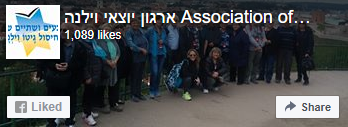The Education System
The local authorities established state elementary schools which closed on Shabbath, where religion and Judaism were taught in Polish. Influential Jews were worried that these schools, called Matriculation one-stop-shops, would distance the children from Judaism, however about 6,000 Jewish children went to these schools.
The head of the Education Department was the Zionist, Dr. Josef Berger. Many teachers opposed his demand to also teach Hebrew in those schools where the lessons were taught in Yiddish. The Education Department supervised the kindergartens, nutrition for the students, libraries and museums, held pedagogical courses for ‘Tarbut’ teachers and those working for the Central Education Committee as they wanted to train the teachers in a realistic and national-humanist track.
There were two teachers’ associations in the city:
- Hebrew teachers
- Yiddish teachers
There were five main education institutions in Vilna:
- Central Education Committee: was in charge of secular education in Yiddish, in response to the expansion of education in other languages. It ran the kindergartens, five schools and the Real Gymnasium high school, where the subjects were taught in Yiddish. At the end of the 1930s, the Gymnasium was given state recognition so that the matriculation exams could be held in Yiddish and the graduates could enroll in university. The Education Committee published textbooks, maps, two journals – one for children and the other for teenagers and adults – as well as pedagogical brochures.
- The Zionist-Yiddish Education Network: At the end of the 1920s, a Yiddish school, Schul Kolet, was founded with about 2,000 students learning in the various schools of the network.
- The Zionist-Hebrew School Network called ‘Tarbut’ started operating in Vilna in 1925. The network operated kindergartens, an elementary school and a Gymnasia Realit (which closed in 1931), as well as a Hebrew Seminary for kindergarten teachers – the only one in Poland. The network published popular informative literature for teenagers.
- The Education Network of the Tachkemoni United Committee included 11 schools, a private religious gymnasia and teachers’ courses. About 300 children studied at the municipal Talmud Tora, a school with six departments. About half the children were orphans from a boarding school. They were exempt from tuition fees and received free lunch and books. About 1,500 students studied at the network's institutions.
- The Horev Center (Yavneh) ran an elementary school and supported about 20 Yeshivas and about 200 Haredim in Vilna and the vicinity, attended by about 1,4000 students.
The ghetto enjoyed a rich and varied cultural life with preference being given to the children and their education. Immediately following the confinement of the Vilna Jews in the ghetto, the first schools were opened. Lessons were often interrupted because of the Aktions but were renewed at the end of November. A kindergarten was set up for those children whose parents worked outside of the ghetto. At various times, about 700 – 900 children aged 5 – 12 studied at the elementary schools. 120 students studied at an elementary school which had been established at the Kailis Camp. There was also a high school in the ghetto with four classes and about 100 students. A teachers’ association was formed with approximately 100 members. The association held lectures on education as well as general topics. A short while after the ghetto had been established, two schools were founded. This was done at the initiative of the teachers and the support of the Judenrat. In November 1942, a third school was added. Following a period of Aktions, the number of students evened out to about 1,500. There were also two kindergartens and a high school with about 100 students. Professional courses were provided for the boys and girls and the graduates even received Scheins. There was also a music school with about 100 students.
Celebrations and ceremonies relating to various Jewish holidays and historical-literary events were held at the schools. The relationship between teachers and students was very close and emotional, and activities were very intense. Karok mentions in his diary that, on 8th March 1942, after attending two rallies: “Life bursts forth from within the cloak of Paneriai, striving for a better tomorrow… today was like a small Yom Kippur for me. I could not control myself and the tears flowed as if from a spring… a hall was full of people crying … it is difficult to say what it means to cry in the Vilna Ghetto”.
A youth club was established in the ghetto for 16 – 18-year-olds, as well as a children’s club, which provided diverse and amazing group activity, such as law and history, drama, literary lectures etc. Yitzhak Rudashevski expresses this enthusiastically in his diary on 9th January 1943: “This evening, there was a big celebration at the club … our dramatic circle showed its resources and ability until midnight …our spirit, which we carry proudly within the walls of the ghetto, will be the most beautiful gift for a shining future. Long Live the Youth! A prelude for our People”.
The Judenrat proffered its opinion regarding the care of children, orphans and children in distress, and set up a boarding school for boys, one for girls, an orphanage for preschoolers and a day-care center for children whose parents worked outside the home. The school curriculums were eventually formulated following differences of opinion and, in addition to Yiddish and general subjects, included Hebrew, the Bible and subjects of the Land of Israel.
From: Hili Bitan Roei Kakon, Segev Cohen, Rotem Cohen – the Vilna Ghetto website, 12th grade, Ort Ebin High School, Ramat Gan

